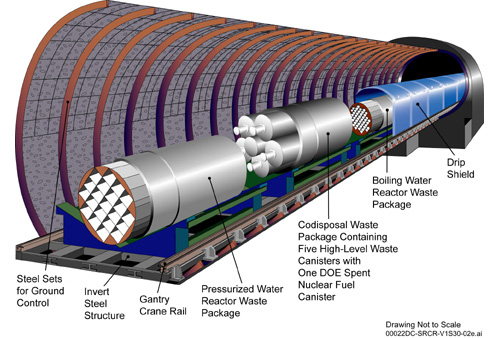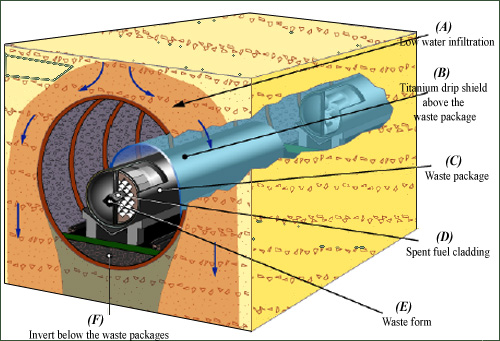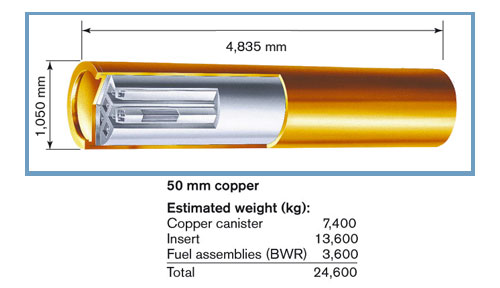Underground disposal of spent fuel – A long-term option
Spent fuel assemblies unloaded from reactors are highly radioactive materials. In many countries, the dominant thinking is to treat them as ultimate waste that will one day have to be disposed of in large underground facilities. These radioactive materials contain around 1% plutonium. Once buried, they will release 10 times more heat than vitrified waste (which is obtained after extracting the plutonium), and the heat release will remain intense for longer.
The deadline for building such repositories is still a long way off. In most cases, dates such as 2040 or 2050 are on the table. Two small nations, Sweden and Finland, are the most advanced in this area, with plans to build repositories by around 2020.

Containers for Yucca Mountain
This cross-section of a tunnel of the disposal facility under Yucca Mountain in the Nevada desert, shows three types of waste container: fuel assemblies for pressurised water reactors and boiling water reactors (in the foreground and background), and high-level waste packages (in the middle). Note the titanium drip shields designed to protect the containers against water dripping from the tunnel roof. Although Yucca Mountain is subject to a desert climate, layers of tuff (compacted ash) are not as impermeable as clay. This was one of the reasons for which the project was abandoned.
© OCRWM/DOE
The United States were expected to become one of the first countries to operate such a repository, under Yucca Mountain in the Nevada desert. The project was abandoned in 2009. Despite being cancelled, the American spent fuel disposal project illustrates what such a facility might look like, and identifies the challenges to be overcome.
The role of the waste containers is to confine radioactive materials for an extended period. The containers consist of two thick, corrosion-resistant metal cylinders: a stainless steel inner cylinder and a nickel alloy outer cylinder. A titanium shield around the waste packages prevents dripping water and falling debris from striking the packages.
Waste containers would rest on an “invert”: a steel structure filled with crushed volcanic rock, designed to impede the movement towards the rock of any radioactive particles that might eventually be released from the containers. In addition, fuel pellets inside the containers are isolated from the exterior by long zirconium alloy cladding assemblies. In principle, heavy atoms such as uranium and plutonium are not very mobile.

Spent fuel repository concept
Geological disposal concept for spent fuel packages envisaged for the Yucca Mountain project.
© DOE
The natural obstacles present at the site and its remote desert location were assumed to greatly dilute any radioactive materials released from the repository. The solid rock would retard the transport of any radioactive materials escaping from waste containers and the remote location would minimise the impact on human populations of radioactive material from the facility.
According to the US Department of Energy, the repository and engineered barriers were designed to geologically isolate highly radioactive waste for thousands of years. Nevertheless, the intense heat and radioactivity from the spent fuel might compromise the waste containers’ sealing function. Despite the geological and engineered barriers, there was considerable controversy relating to the planned facility’s ability to totally isolate highly radioactive waste for thousands of years.

Swedish KBS-3 copper overpack
In the Swedish solution, engineers erected five barriers to delay the migration of radioactive atoms: 1) the mater of uranium oxide fuel pellets; 2) metal cladding of the fuel rods surrounding the afore mentioned pellets; 3) iron cylinders binding the fuel rod assemblies together; 4) a thick copper cylinder acting as an outer coating around the iron cylinder; 5) bentonite, a swelling clay, impermeable to water, surrounding the copper cylinder to immobilise radioelements.
© SKB
Sweden has a small fleet of four reactors. It was the first nation to consider abandoning nuclear power, in the 1980’s, and is currently building the first spent fuel repository. Finland is close behind.
Sweden, which does not intend to reprocess its spent fuel, has developed a disposal process. The Swedish concept, known as KBS-3, consists in placing the spent fuel in long, sealed iron containers surrounded by copper. These containers are then stored in granite 500 m underground. The overpacks designed for waste disposal in granite, which is the only suitable geological formation available in Sweden, will be placed in cells that are backfilled with bentonite, a swelling clay that, when saturated with water, becomes totally impermeable, preventing any water that naturally circulates through the granite from reaching the waste packages.
Bentonite will also be used to seal the tunnels and cells. Experiments are being conducted at the Aspö underground laboratory in order to validate the various aspects of this repository.
Other articles on the subject « Waste Conditioning »
Vitrified High Level Waste
Glass – A very resistant matrix for high-level waste After the uranium and plutonium have b[...]
Resistance of R7T7 glass
Assessing the resistance of vitrified waste over millennia Is nuclear power a clean industry? To [...]
Packaging Intermediate-level waste
Compaction for hulls and end caps… The zirconium alloy cladding around the uranium oxide pellets [...]
Low and very low level waste
Basic conditioning for low-level and very low-level waste Waste in which the radioactivity is low[...]
Radioactive Waste Containers
Canisters and containers for various types of waste France’s National Evaluation Commission[...]